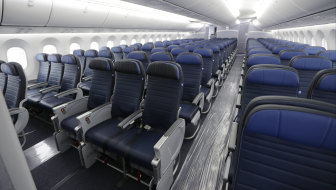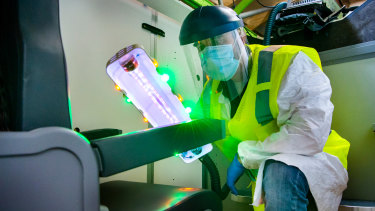‘Witches’ cauldron’: Coughing dummies help track viruses on planes
For the past four months, United Airlines and Boeing have been flying around jetliners loaded with mannequins, aerosol sprays, sensors and scientists in an effort to understand how contaminated air moves through passenger planes.
The research is just one small part of a sweeping global campaign to figure out the threats posed by the coronavirus.
But for the airline industry, the results could help determine how quickly carriers bounce back from the edge of disaster after the pandemic made people afraid to get on a plane. US demand for flights remains at less than a third of 2019 levels, based on airport security screening data.

The US military initiated the study when the spread of COVID-19 raised concerns about infection risks for troops transported on passenger jets. Companies including United, Boeing and Zeteo Tech, a Maryland-based biodefense and medical device maker, are contributing equipment and expertise.
If the findings can show how likely it is for a passenger to be infected by breathing the air on a plane, “it’ll probably drive some policy decisions,” said Mike McLoughlin, Zeteo’s vice president of research.
Reassuring flyers
Airlines have sought to reassure the public that flying is safe by implementing an array of onboard cleaning and disinfecting procedures, requiring face masks in the cabin and improving ventilation and filtration systems. But they haven’t been able to show what, precisely, are the chances of infection if that person sitting next to you or across the aisle breaks out into a virus-laden cough.
To collect the data, researchers placed mannequins with human-like heads in various seats throughout seven models of Boeing and Airbus jets, then made them cough. Or rather, they simulated a human cough, and how aerosolised particles are expelled and disseminated through the air on the plane, McLoughlin said.

Aerosol particles will behave differently under different cabin scenarios, said Byron Jones, an engineering professor at Kansas State University who studies airline cabin air and was not involved in the project. Gas and particles in a cabin become “a witches’ cauldron,” he said, based on air flows, particulate sizes and other factors. “It just swirls and churns and twists. It’s very chaotic,” he said. But that churning isn’t necessarily a bad thing: “That’s what you want to see in a general ventilation (system).”
Researchers evaluated how factors such as circulation, the exchange rate of cabin air, filtration and forward-facing seats affected the flow of aerosolised particles through the cabin, and who would be most exposed in their proximity to a cougher. Particle sizes and various locations throughout the cabin were considered. Tests were repeated with the dummies wearing disposable surgical masks.
Results in October
The tests were conducted during 30 hours in flight and 24 hours on the ground from May 5 through August. Analysis of the data and peer reviews are expected to be completed this month with a final report issued in October.
Boeing declined to comment on the results they’ve seen so far. In a statement, the company said it’s approaching the question of virus spread “from an engineering perspective by conducting data-driven analysis studies, simulations, modelling and live testing, which will help us all better understand the transmission and risks of COVID-19.”
The project is funded and led in part by the US Transportation Command, based at Scott Air Force Base in Illinois, which buys airline seats and charter flights to transport US troops and their families around the world. The Command sees the study as critical to safely mobilising troops, said Lieutenant Colonel Ellis Gales jnr, a spokesman. The Defense Advanced Research Projects Agency helped connect the Transportation Command with United and Boeing.
If the analysis shows infection risks through the air can be controlled on a plane, the industry might be able to use those results to help persuade the public to start flying again even before a vaccination for COVID-19 might be widely available.
“Throughout the pandemic, our top priority has been the health and safety of our customers and crew,” Toby Enqvist, United’s chief customer officer, said in an email. Enqvist said he’s encouraged by the early results he’s seen, but did not provide specifics.
“Everybody is keen to get the results out as quickly as possible but we want to make sure that when we release those results we’re painting an accurate picture,” McLoughlin said.
Most Viewed in Business
Source: Thanks smh.com